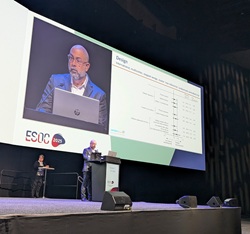
Halving the frequency with which vital signs and neurological function are checked in low-risk patients after treatment for acute ischaemic stroke does not compromise care or recovery outcomes, according to new findings presented today at the 11th European Stroke Organisation Conference (ESOC; 21–23 May, Helsinki, Finland).
Results from the OPTIMISTmain study—which have also been simultaneously published in The Lancet—showed that this approach held further benefits for nursing workflow and intensive care resources. The trial was led by Craig Anderson (The George Institute for Global Health/University of New South Wales, Sydney, Australia) and Victor Urrutia (Johns Hopkins University School of Medicine, Baltimore, USA), who presented late-breaking data at ESOC 2025 alongside Debbie Summers (Saint Luke’s Hospital of Kansas City, Kansas City, USA).
According to Anderson, guideline-recommended monitoring in the 24-hour period immediately after intravenous thrombolysis (IVT) treatment, originally developed in the 1990s, takes up considerable nursing time and intensive care unit (ICU) beds.
“As well as shifting nurses’ attention away from other aspects of care, such as education, counselling, and supporting anxious family members, this level of monitoring disrupts patients’ sleep and may not even be needed for those considered to be ‘low risk’,” he stated.
To find out whether the frequency of monitoring could be safely reduced, OPTIMISTmain researchers studied a total of 4,515 patients with acute ischaemic stroke at hospital sites across eight countries, including four high-income countries (Australia, Chile, the UK and the USA) and four low- and middle-income countries (China, Malaysia, Mexico and Vietnam).
Patients were either monitored according to a low-intensity protocol, meaning 19 assessments over the course of 24 hours post-thrombolysis, or standard care, meaning a total of 39 assessments.
In both groups, vital signs and neurological assessments were conducted every 15 minutes in the first two hours. Over the subsequent eight hours, patients were monitored every two hours in the low-intensity monitoring group versus every 30 minutes in the standard group. Up until 24 hours, the low-intensity group were checked every four hours versus hourly monitoring in the standard group.
A comparable proportion of patients experienced a poor functional outcome—death or disability (modified Rankin scale [mRS] score 2–6) after 90 days—with 809 of 2,552 participants (31.7%) in the low-intensity group and 606 of 1,963 (30.9%) in the standard monitoring group reaching this outcome.
The occurrence of intracerebral haemorrhage (ICH), which has been established as the most serious complication of thrombolytic therapy, was low in both groups, being observed in 0.2% of patients in the low-intensity group and 0.4% of patients in the standard monitoring group. Serious adverse event rates were also similar between the low-intensity and standard monitoring groups at 11.1% and 11.3%, respectively.
Anderson’s view is that, with these results, OPTIMISTmain is the first study conducted on this scale to show that low-intensity nursing is safe and effective in stroke care.
“Regular monitoring during the first hours of stroke onset is critical, but we felt that hourly checkups may be unnecessary in the subsequent 24 hours,” he commented. “Our findings show that low-intensity monitoring is safe and does not compromise patient recovery, outcomes, or satisfaction with care. We expect this approach will be adopted by hospitals worldwide, especially where resources are constrained, as it can streamline care and enable nurses to spend more time on other important aspects of the complex care of these patients.”
As well as freeing up nursing time, the protocol was seen to have improved availability of ICU beds—particularly in the USA, where the proportion of patients admitted to ICUs was 30% lower among hospitals adopting low-intensity monitoring.
While senior author Urrutia conceded in his ESOC presentation that these findings may only constitute “weak-level evidence” demonstrating the non-inferiority of low-intensity versus standard monitoring in patients with mild-to-moderate neurological impairment, he added that this new approach could support more resilient stroke care moving forward.
“This study was partly conducted during the COVID-19 pandemic, when healthcare resources were under extreme strain,” Urrutia said. “While we may have overcome many of the pressures of that period, shortages in healthcare staff and hospital beds persist. We anticipate that a lower-intensity monitoring system for eligible stroke patients will help alleviate the capacity challenges that continue to threaten high-quality stroke care.”









